Slot machines look simple. You press a button. Reels spin. Symbols line up. You win or lose. But behind that spinning action sits a system that determines every outcome: paylines.
These invisible paths across the reels decide whether your spin pays out. They follow specific patterns that you can learn. Most players spin without knowing how paylines work. They miss opportunities and make bad bets.
The basics: what paylines actually are
A payline is a pattern determined beforehand along which matching symbols have to fall to form a winning combination. The route resembles the one that links left-to-right positions of symbols.
The simplest slots have one payline. It runs straight across the middle of the reels. Three matching symbols in a row equals a win.
Modern slots are different. They pack in dozens of paylines. Some have 20, others 50, and many push past 100. All the lines have their own track on the reels. Horizontal, diagonal, zigzag. They are woven and intertwined.
But the rule stays the same. Matching symbols must land on the same payline to trigger a win. The symbols must connect from the leftmost reel moving right.
Fixed vs. adjustable paylines
Slots handle paylines in two ways. Fixed paylines force you to bet on all available lines. Every spin activates every payline.
Adjustable paylines let you control how many lines you play. Want to bet on just five lines instead of twenty? Your total bet drops, but so do your chances of winning.
Most modern slots use fixed paylines. The math works better for both players and casinos. You get maximum winning opportunities on every spin.
For players serious about maximizing their chances, sites dedicated to high-payline games become valuable resources. Many players find that the best payline slots are those with 76 paylines. These games hit the sweet spot between complexity and playability: more winning opportunities than basic slots but without the overwhelming chaos of 243+ ways-to-win formats.
How wins are calculated on paylines
Each payline operates independently. You can win on multiple paylines during the same spin. The slot adds up all winning paylines to determine your total payout.
Symbol combinations pay different amounts. Three cherries might pay 5x your line bet. Four cherries could pay 25x. Five cherries might jump to 200x.
Your line bet matters here. If you bet $0.10 per line and hit a 25x multiplier, you win $2.50 on that payline. The same combination with a $1 line bet pays $25.
Wild symbols change the equation. They substitute for other symbols to complete paylines. A wild can turn a losing spin into a winner by filling gaps.
Scatter symbols work differently. They don’t follow paylines at all. Land three or more anywhere on the reels and they trigger bonuses or free spins.
Reading payline maps
Every slot displays its paylines somewhere in the interface. Look for a payline map or button labeled “lines.”
The maps use numbers to identify each payline. Payline 1 might run straight across the middle. Payline 2 could zigzag up and down. Payline 20 might follow a complex diagonal pattern.
Some slots let you highlight individual paylines while you play. Click on a payline number and the game shows that path across the reels.
Don’t memorize every payline pattern. The slot calculates wins automatically. But knowing the general layout helps you see why certain symbol combinations pay while others don’t.
Strategy considerations
More paylines don’t guarantee more wins. They create more opportunities for wins. But each opportunity still depends on random number generation.
High-payline slots tend to hit more frequently. You’ll see small wins regularly. But individual payouts might be smaller to compensate.
Low-payline slots often have bigger individual payouts. But wins come less frequently. The volatility feels different.
Your bankroll strategy should match the payline structure. High-payline games work well for longer sessions. Low-payline games suit bigger hits.
Paylines vs ways to win
Some modern slots abandon traditional paylines entirely. They use “ways to win” systems instead. These count any matching symbols in adjacent reels, regardless of position.
A 243 ways to win slot has five reels with three symbols each. Any matching symbols in consecutive reels create wins. You don’t need symbols to line up on predetermined paths.
This system usually produces more frequent wins than traditional paylines. But the individual payouts adjust accordingly.
Making informed choices
Paylines do not alter the overall RTP percentage of the slot. A 96% RTP slot will pay 96% as well whether it has 10 paylines or 100 paylines.
But paylines do affect volatility and hit frequency. More paylines typically mean more frequent small wins. Fewer paylines often mean less frequent but larger wins.
Your bet is also affected by the number of paylines. A 50-payline slot machine having a minimum bet of 0.01 line will cost at least 0.50 per spin.
Progressive jackpots are activated independent of payline combinations, and increase until a winner is hit.
Conclusion
Paylines are the essence of slot machine games. They decide which symbol combinations pay out and how much you will receive. Knowing them allows you to pick games that fit with your playing style and bankroll.
The payline configuration determines your overall gaming experience, whether you prefer stable action or bigger swings. Smart players use this knowledge to find their ideal slot format.


